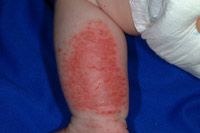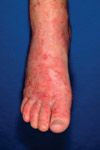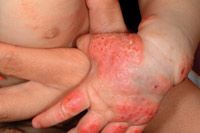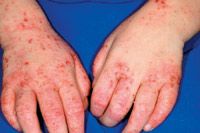- General Dermatology
- Eczema
- Chronic Hand Eczema
- Alopecia
- Aesthetics
- Vitiligo
- COVID-19
- Actinic Keratosis
- Precision Medicine and Biologics
- Rare Disease
- Wound Care
- Rosacea
- Psoriasis
- Psoriatic Arthritis
- Atopic Dermatitis
- Melasma
- NP and PA
- Skin Cancer
- Hidradenitis Suppurativa
- Drug Watch
- Pigmentary Disorders
- Acne
- Pediatric Dermatology
- Practice Management
- Prurigo Nodularis
Article
Helping the children: Combination therapy typically first-line treatment for AD
Combination therapy is typically first-line therapy for children with atopic dermatitis. The dermatologist's task is to personalize treatment to optimize the patient's response, an expert says.

Key Points

"Combination therapy is the mainstay of treatment for atopic dermatitis," says Anthony J. Mancini, M.D., head of pediatric dermatology at Children's Memorial Hospital in Chicago, where he is a professor of pediatrics and dermatology at Northwestern University's Feinberg School of Medicine.

The task with the moderate-to-severe cases is to optimize the patient's response to treatment, typically with a multifaceted treatment plan, Dr. Mancini says.
When discussing the plan with parents, the clinician should be straightforward and acknowledge that the treatment is labor-intensive for the first few weeks, but that the patient will likely improve with this approach.

The dermatologist should also stress that AD is a manageable disease, although not currently curable, and that the patient needs to be followed closely early on in the treatment course.

Personalized care

For dry skincare, Dr. Mancini prefers the "wet method" of keeping skin hydrated, as opposed to the "dry method" of less frequent bathing.
The "wet method" needs to be used properly in order to be effective, he says. For patients with AD, this consists of short daily baths that are five to 10 minutes in duration. Patients should use tepid rather than hot water, blot dry the skin following bathing, apply the prescribed topical medication(s) to affected areas, and apply an emollient cream or ointment to "lock in" both the medication and moisture.
"The 'wet method' works partially by hydrating the skin," Dr. Mancini says.
"We know that squamous keratinocytes swell with exposure to water. There also appears to be an accentuated penetration of the topical medications, and the emollient seals the treatment in.
"Daily bathing can also assist in manual debridement of bacteria, such as staphylococci, that are often found on the surface of such skin.
"For parents of young children, bath time is a ideal time for bonding, and for older kids, there is a psychological benefit to the feeling of being clean," Dr. Mancini says.
He recommends thicker creams or ointments as emollients, and notes that several newer prescription "topical nonsteroidal barrier creams" are also available.





